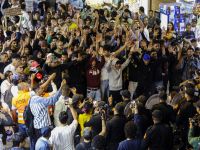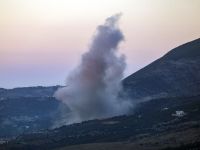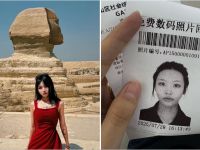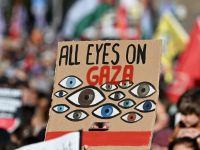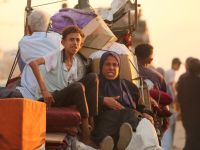Arguably the Middle Eastern leader most perturbed by Friday’s attack by Hizbollah guerillas on an Israeli army convoy, in which one Israeli soldier was killed, was Lebanese Prime Minister Rafik Hariri.
Just one day earlier, during a meeting with French business executives in Paris, Hariri had sought to calm the jittery nerves of potential investors. “We shall not provoke and we will not succumb to provocation,” he told his audience. “We have a clear agreement with our Syrian brothers in this matter. There will be no provocations on our part.”
On Sunday, following the attack, Hariri made an urgent visit to Damascus to discuss this latest development with Syria’s president, Bashar el-Assad. Earlier, he had reportedly spoken to Iranian officials, evidently asking that they exert their influence and rein in Hizbollah.
Friday’s attack emphasized once again what a complicated place this region of the Middle East actually is. It occurred in the Shabaa Farms area, which is a 20-square-kilometer strip of land occupied by Israel, and bordered by Lebanon and Syria. The area has been held by Israel since 1967, when it captured the Golan Heights from Syria. Lebanon’s claim on Shabaa farms predates 1967 and previously was directed against Syria.
When Israel withdrew unilaterally from Southern Lebanon in May 2000, it held on to Shabaa Farms. The Lebanese government appealed to the United Nations, claiming that Israel had not complied with UN resolutions and removed its forces from all of Lebanon. But the UN Security Council accepted Israel’s claim that the area in question had been occupied from Syria and thus did not fall within the framework of Security Council Resolution 425, which called for Israel’s withdrawal from Lebanon. From its perspective, the United Nations said, Israel had pulled back its forces to the international border.
Following the Hizbollah attack, Israeli fired retaliatory rounds of artillery for about 30 minutes, Reportedly between two and five guerrilla fighters were killed.
Hariri finds himself caught between a rock and a hard place. Recently re-elected as prime minister, largely on the basis of his promise to restore Lebanon’s moribund economy, he is well aware that vitally needed investment income will be forthcoming only if foreign investors can be convinced that Lebanon’s security risk is negligible. In this respect, an upsurge in violence in Southern Lebanon could be devastating.
But Hariri is reluctant to rebuke Hizbollah publicly. He is well aware that the Shiite Muslim movement enjoys wide popularity, especially since it is considered by many of his countrymen to have won a famous victory last year, when Israel hurriedly retreated under its fire, and received nothing concrete in return. Also, Hariri cannot say anything that may be construed as relinquishing the country’s claim on Shabaa Farms.
Hizbollah clearly has a different agenda than Hariri's. As it makes the transition from a resistance movement to a player in the Lebanese political arena, it seeks to gain public support by doing what it knows best — going after the Zionist enemy.
Even Syria, who one would believe would oppose actions made in the name of a Lebanese struggle for a strip of land that it too claims, sees a definite value in the Hizbollah attacks. For years, Southern Lebanon was a region where Syria, by proxy, could maintain military pressure on Israel, without itself becoming directly involved in a costly and risky conflict.
When Israel withdrew its forces from the area, it appeared as if Syria would lose this leverage, but the disputed Shabaa Farms area provided a convenient, if somewhat ironic alternative.
For Hariri, the news of the Hizbollah attack could not have come at a worse time. During meetings he held with the French government that same morning, he had outlined Lebanon’s economic predicament, and reviewed the measures already taken by his government — including tax reform — to increase growth and reduce its budget deficit.
Responding, the French authorities promised to assist Lebanon in obtaining financial assistance. They also called on the Hariri government to exercise control in Southern Lebanon and prevent provocations in the region.
Also on the table was a partnership agreement between Lebanon and the European Union. French President Jacques Chirac and Premier Lionel Jospin both reiterated their support to Hariri toward the successful conclusion of such an arrangement.
Hariri had discussed the EU partnership agreement and investment issues a week earlier, when he met with Romano Prodi, the president of the European Commission. Prodi promised to encourage EU banks and private firms to invest in Lebanon, and also pledged EU support in clearing the minefields that still remain in Southern Lebanon following the Israelis’ withdrawal.
At a press conference after their meeting, Hariri said the prospective partnership agreement with the EU would make Lebanon a center for trade, finance and tourism, and would encourage European businessmen to have a branch or a base in Lebanon.
A conflagration in Southern Lebanon could upset the Hariri government’s well-intended plans. Tension in the area is high, with the Lebanese Army having only consigned a relatively small number of troops to the area, leaving Hizbollah fighters to fill the vacuum. The UN Interim Force in Lebanon, which deployed its blue-helmeted troops to the area, is only partially effective in maintaining the peace, and in any case recently announced its intention to reduce the size of its force in the region.
True to its word, Hizbollah has ignored the existence of the UN-recognized border adjacent to Shabaa Farms. In October, the organization captured three Israeli soldiers patrolling the line, and it killed one soldier in Shabaa Farms in a planned ambush in late November. Friday’s attack was the third incident in less than five months.
Southern Lebanon remains a desolate place. Some 400,000 Lebanese lived there before the Israeli occupation, but in May 2000 only 90,000 remained. In the months that have followed, few of the residents returned to their former homes. In part, this may be due to a lack of economic development in the area.
Two months after the Israeli withdrawal, a meeting of ambassadors from 38 countries and 10 international financial institutions was held in Beirut to discuss giving Lebanon aid to get the South back on its feet. The then-prime minister, Selim Hoss said that in the short term $260 million was needed, and $1.3 billion would have to be invested in the area over a five-year period. The long-term plan calls for $991 million to go toward physical infrastructure, $150 million for social and economic development, and $191 million for the families of those killed, handicapped or detained under Israeli rule.
But the development funding has been slow in coming, and most of what has been done in Southern Lebanon to date amounts to placing plasters over gaping wounds. However, Hariri’s meetings with the European officials over the past two weeks gave rise to hope that the state of the South’s economy was being placed once again onto the international community’s front burner.
For Hariri, of course, the situation in Southern Lebanon is only one of myriad of problems. Preliminary data released in February showed that country's 2000 fiscal deficit widened to about 24 percent of the gross domestic product, from 16 percent a year earlier. The government’s earlier approved budget would reduce the deficit to about 20 percent of GDP in 2001. This would still leave general government debt rising from 135 percent of GDP at the end of 1999 to about 165 percent by the end of 2001.
Foreign investment is one of the few means available to alleviate Lebanon’s dire economic condition, and it is a key element of Hariri’s recovery plan. But such investments would almost certainly be non-forthcoming if the violence in the Shabaa Farms area spreads northward—and especially if Lebanese action—or Lebanese government non-action—is perceived by the international community to be a contributory factor. – (Albawaba-MEBG)
© 2001 Mena Report (www.menareport.com)



